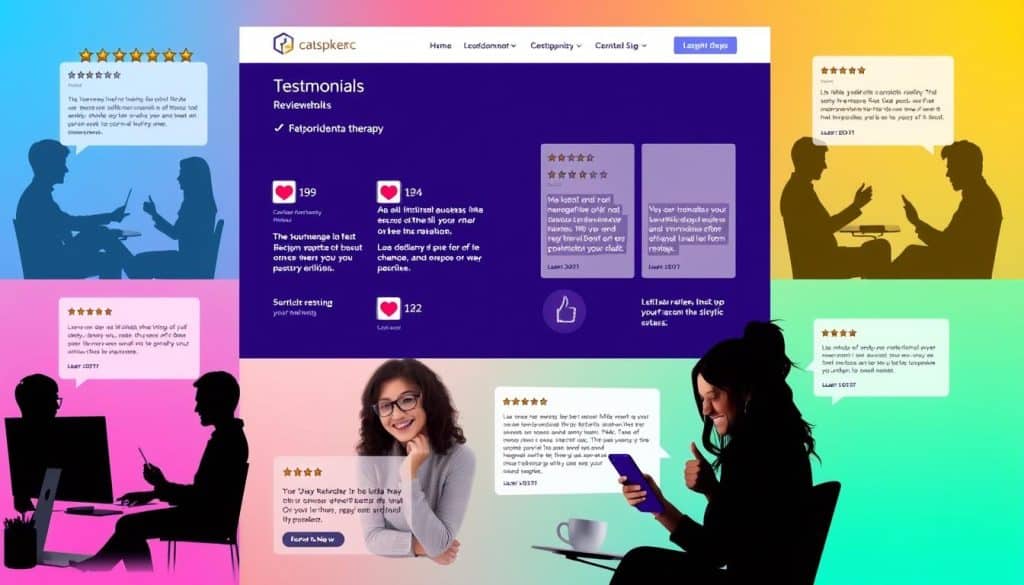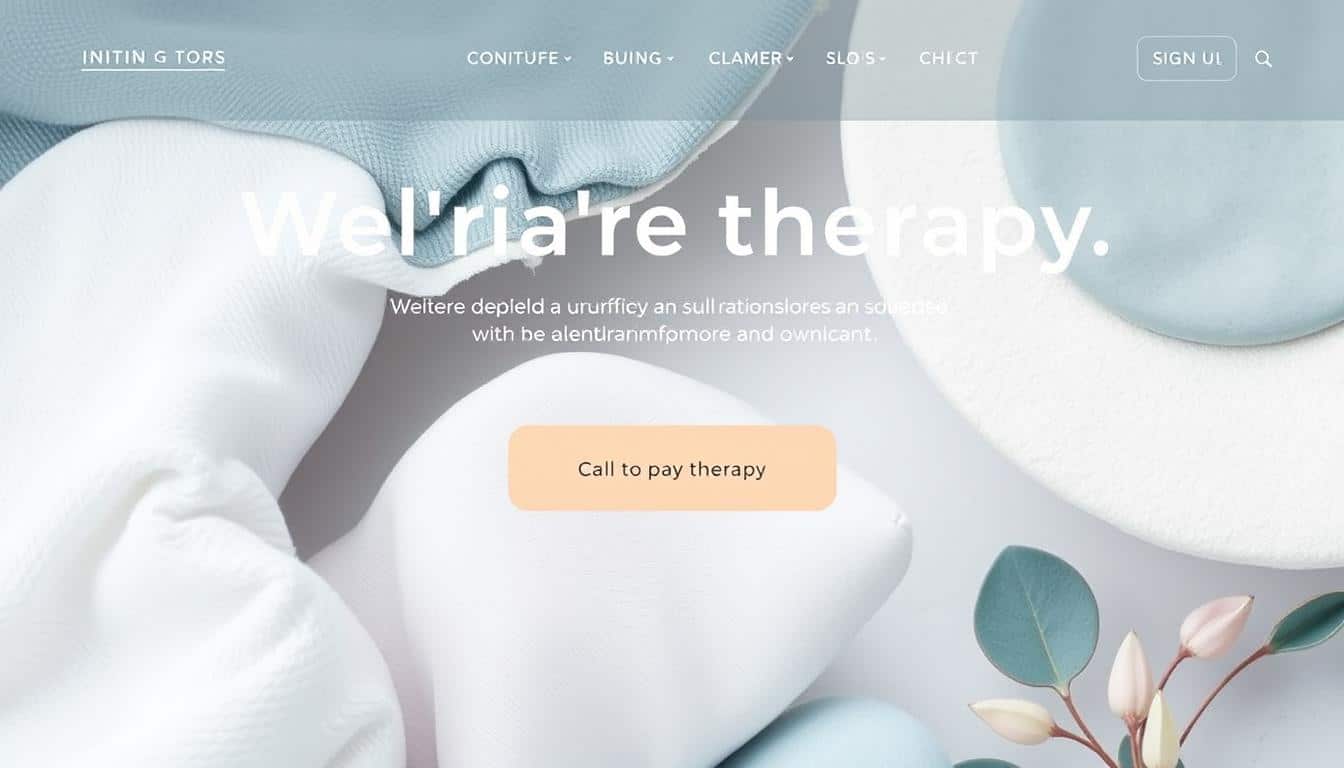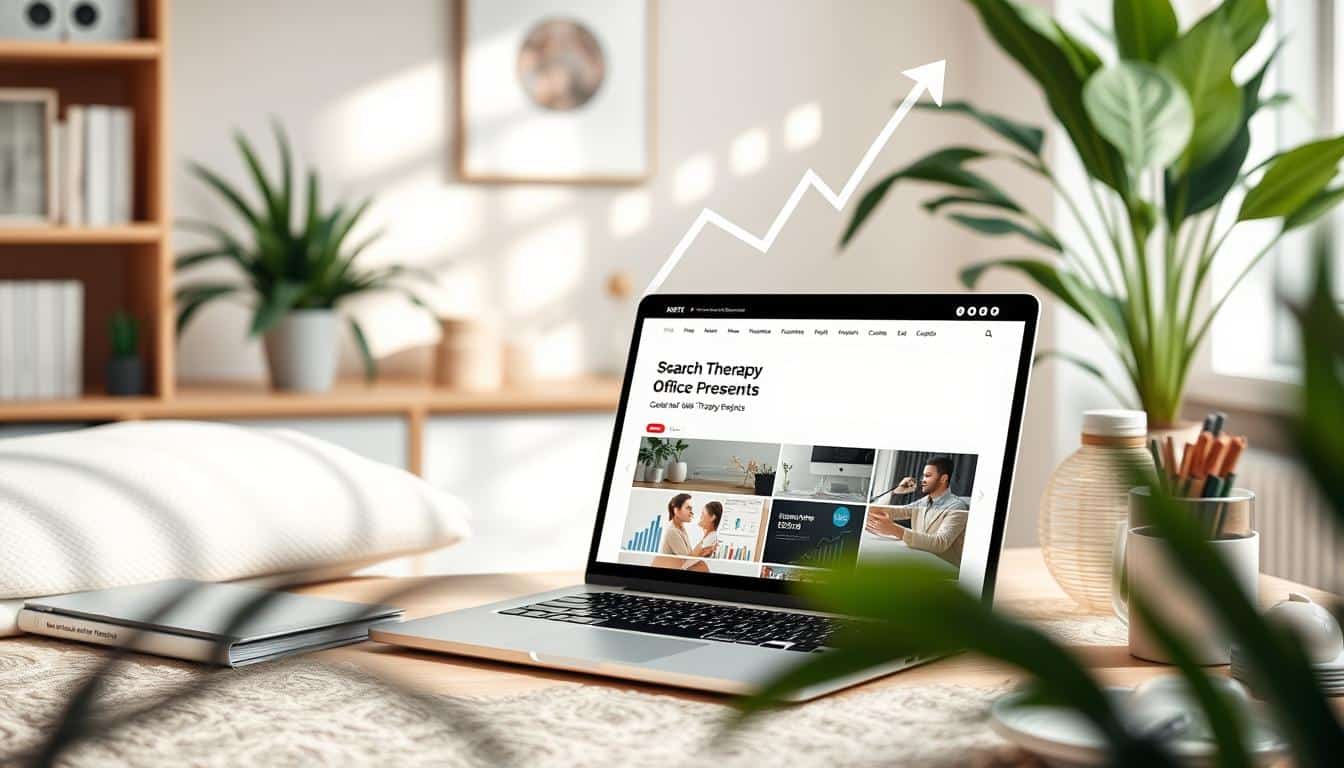Your website is a key tool to draw in and convert potential clients. To boost your therapy website’s conversion rate, a strategic approach to conversion rate optimization (CRO) is essential. This guide offers practical tips to attract more clients, improve your online presence, and increase inquiries and bookings for your practice.
Key Takeaways
- Know your target audience and tailor your messaging to their needs and pain points.
- Make your website easy to use by simplifying navigation and speeding up page loads.
- Use compelling visuals to make a strong and lasting impression online.
- Use clear calls-to-action (CTAs) with action-oriented language and strategic placement.
- Streamline the conversion process by reducing form fields and offering multiple contact options.
Understand Your Target Audience
To boost your therapy website’s conversion rates, knowing your audience is key. Identify their pain points, challenges, and what drives them. This way, you can make your website speak to them, leading to more leads and conversions.
Identify Their Pain Points
Begin by researching the common issues your audience faces. This could be anxiety, depression, or relationship problems. Knowing these problems helps you show how your services can solve them.
Tailor Your Messaging
With a clear understanding of your audience’s needs, create website content that addresses them. Use language that shows you get their struggles and can help. This approach builds trust and boosts your chances of converting visitors into clients.
| Pain Point | Tailored Messaging |
|---|---|
| Anxiety and stress management | Discover proven techniques to regain control and find peace of mind. |
| Relationship difficulties | Rebuild meaningful connections and strengthen your most important bonds. |
| Lack of work-life balance | Achieve greater fulfillment and well-being with our personalized guidance. |
By focusing on optimizing counseling site lead generation and enhancing digital mental health platform engagement, you can attract more website leads. This strategy also helps improve your online presence in the psychology field.
Optimize Your Website’s User Experience
As a therapist, it’s key to [https://www.dreemwebsites.com]boost your online bookings and telehealth inquiries. You need to make your website user-friendly. This means making it easy to navigate and fast to load. A good website keeps clients interested and more likely to book.
Simplify Navigation
Your website’s navigation should be easy to use. Visitors should quickly find what they need. Use a clear menu, search bar, and clear calls-to-action (CTAs) to help them.
This approach [https://www.dreemwebsites.com]improves your conversion rates and keeps clients happy. Happy clients come back for more.
Enhance Page Load Speed
- Optimize images and other media to minimize file sizes without compromising quality.
- Leverage browser caching to reduce the number of resources that need to be loaded on each visit.
- Implement a content delivery network (CDN) to serve static assets from the nearest server, reducing latency.
- Minimize the use of third-party scripts and plugins that can slow down your website.
By improving your website’s UX, you can [https://www.dreemwebsites.com]attract more virtual therapy clients. A smooth online experience encourages visitors to engage with your services. This leads to more loyal clients.
“Improving your website’s user experience is one of the most effective ways to [https://www.dreemwebsites.com]increase online therapy bookings and maximize telehealth service inquiries.”
Leverage Compelling Visuals
When it comes to improving therapy website conversions, visuals are key. High-quality images and graphics make your site more engaging. This can greatly improve your online presence.
Visuals make your site welcoming and trustworthy. They show your expertise and professionalism. This helps connect your services with your audience, leading to more conversions.
- Use attractive stock photos or custom images that match your brand.
- Add infographics or illustrations to explain complex ideas.
- Share client testimonials or case studies in a visually appealing way.
| Visual Element | Benefits |
|---|---|
| High-quality Images | Builds trust, conveys professionalism, and enhances user engagement. |
| Informative Graphics | Simplifies complex information, improves understanding, and increases conversions. |
| Visual Testimonials | Generates social proof, boosts credibility, and encourages user action. |
By leveraging compelling visuals, you can make your digital presence more engaging. This will resonate with your audience and help your therapy practice succeed.

“Visuals are not just an added bonus – they are an essential component of an effective digital strategy. They have the power to transform the way your audience perceives and interacts with your therapy services.”
Implement Clear Calls-to-Action
It’s key to show clear and strong calls-to-action (CTAs) on your website for conversion rate optimization for therapists and increasing online therapy bookings. Use words that push visitors to book an appointment or ask for a consultation. This helps boost virtual therapy client acquisition and maximize telehealth service inquiries.
Use Action-Oriented Language
Make your CTAs strong with words that make people act fast. Phrases like “Book Now,” “Schedule a Consultation,” or “Get Started” are great. Stay away from soft or unclear language that might confuse visitors.
Strategically Place CTAs
- Put CTAs where they matter most, like after helpful content, at page ends, or in sidebars.
- Make sure CTAs pop out with contrasting colors and clear designs.
- Think about using several CTAs with different messages or spots to meet various user needs.
With clear and well-placed calls-to-action, you can lead your website visitors to the actions you want. This will help increase online therapy bookings and maximize telehealth service inquiries.
Streamline the Conversion Process
To boost improving therapy website conversions and optimizing counseling site lead generation, streamlining your website is key. Make your site easy to use by cutting down form fields and offering various contact methods. This approach makes it simple for people to reach out, encouraging them to move forward.
Reduce Form Fields
Less is more when it comes to form fields. Fewer fields mean less hassle for visitors, leading to more successful conversions. Think about what you really need to know and remove the rest to keep things simple.
Offer Multiple Contact Options
Give people different ways to get in touch, like phone, email, or online booking. This meets the needs of more people. Some might like booking online, while others prefer a call or email. Offering choices helps more people find their way to your services.
| Contact Option | Advantages |
|---|---|
| Phone | Allows for immediate personal interaction and real-time communication |
| Offers flexibility for clients to reach out at their convenience | |
| Online Booking | Provides a seamless and accessible scheduling experience |
By making these changes, you make it easier for people to find your therapy services. This includes individual therapy and couples therapy.
Utilize Social Proof
In the competitive world of digital mental health, building trust is key. Social proof is a powerful tool to enhance your psychology practice’s online presence and engagement on digital platforms.
Display Compelling Client Testimonials
Show your expertise and past clients’ positive experiences on your website. Their testimonials can help users feel more confident in reaching out. Choose reviews that show your compassionate care, confidentiality, and personalized treatment.
Showcase Your Credentials and Awards
Highlight your professional credentials, certifications, and awards to build trust. Displaying this on your website shows your commitment to quality care. It proves your dedication to delivering top-notch mental health services.
Using social proof effectively communicates the quality of your services. It shows the trust your clients have in you. This is crucial for a strong online presence and engaging with your audience.

“The staff at [practice name] truly care about their clients and go above and beyond to ensure our needs are met. I feel safe and supported throughout my therapy journey.”
therapy website conversion rate optimization
Your website is a powerful tool for connecting with potential clients. It’s crucial to focus on therapy website conversion rate optimization. By monitoring and refining your website, you can unlock new opportunities for growth.
Start by analyzing your target audience and their pain points. Understand their specific needs and concerns. This will help you craft messaging that resonates and compels them to take action.
Leverage Compelling Visuals
Visuals are key in captivating your audience and driving conversions. Use high-quality, emotive images and videos. These can effectively convey the benefits of your therapy offerings and create a lasting impression.
| Metric | Baseline | Optimized | Improvement |
|---|---|---|---|
| Therapy Website Conversion Rate | 8% | 14% | 75% increase |
| Average Time on Page | 2 minutes | 4 minutes | 100% increase |
| Bounce Rate | 45% | 28% | 37% decrease |
By testing and refining your website, you can find the most effective strategies. Embrace a data-driven approach and use user behavior insights. Implement A/B testing to optimize your website’s conversion rate.
“Optimizing your therapy website for conversions is a game-changer. It’s the key to unlocking your full potential and connecting with the clients who need you most.”
Remember, effective conversion rate optimization is an ongoing process. Stay vigilant, analyze your data, and refine your strategies. Ensure your website is working as hard as you are to improve therapy website conversions and drive growth for your practice.
Continuously Test and Refine
To boost your therapy website’s conversion rate, use data to guide you. Test different elements and study user behavior. This way, you can find new ways to improve your online strategy and get better results.
Conduct A/B Testing
A/B testing lets you try out different parts of your website. This includes your messages, design, and calls-to-action (CTAs). By comparing two versions, you can see which one works best for your audience. This helps you create a better user experience.
Analyze User Behavior Data
Look closely at your website analytics to find patterns. This data shows how visitors interact with your counseling site lead generation efforts. By tracking things like page views and form completions, you can spot what’s not working. Then, you can make changes to improve your website.
By always trying new things and making decisions based on data, you can make your therapy website better. The secret to success is being open to testing, learning, and changing to meet your audience’s needs.
Implement Retargeting Strategies
In your quest to boost virtual therapy client acquisition and maximize telehealth service inquiries, retargeting is key. It helps you reach out to users who’ve visited your site but haven’t booked yet. This could be for an appointment or a consultation.
Retargeting ads can be shown to these users as they browse online or on social media. These ads remind them to visit your site again. By using data on their behavior, you can send messages that really speak to them. This can help increase online therapy bookings.
You can also make your website more personal for returning visitors. This might include showing them relevant blog posts or client testimonials. Or, you could offer a special deal to encourage them to book.
Retargeting is a smart way to keep leads engaged and boost virtual therapy client acquisition. By always being in their thoughts and offering a personalized experience, you can get more people interested in your services. This can turn interested users into loyal clients.
Conclusion
By using the conversion rate optimization strategies from this guide, you can increase your therapy website’s conversion rate. This will help you attract more clients and grow your practice. Always keep an eye on your site, test new things, and make changes to keep your user experience top-notch. This way, you’ll meet the changing needs of your target audience.
Using methods like optimizing counseling site lead generation and increasing online therapy bookings can boost your site’s engagement. It also helps in maximizing telehealth service inquiries. Plus, driving counselor website leads and optimizing your psychology practice’s online presence can greatly improve therapy website conversions. This will help your business grow.
Remember, conversion rate optimization for therapists is a continuous effort. By always testing and refining your strategies, your therapy website will keep delivering great results. This will help you reach the clients who need your services the most.



